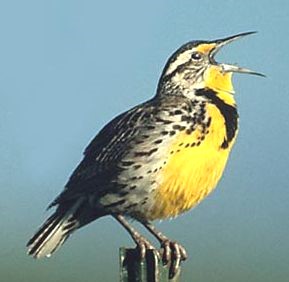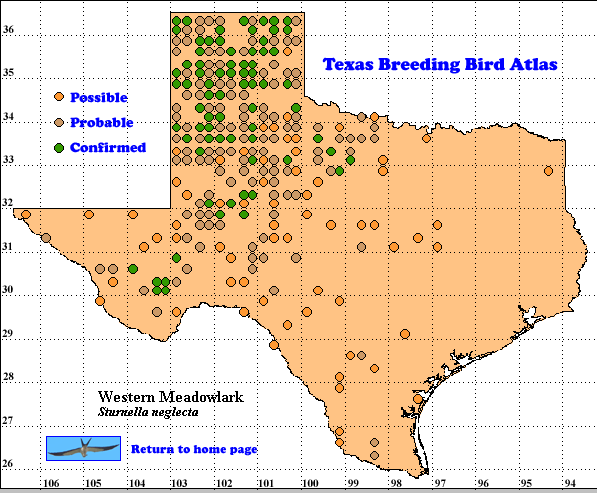The Western Meadowlark (not a lark, but a New World blackbird) is a common and conspicuous bird. Six states have made it their state bird. This species was formerly lumped with Eastern Meadowlark (S. magna) as Meadowlark. The species is an omnivorous feeder, typical of blackbirds. It consumes insects and plant materials (Lanyon 1994).
Western Meadowlark, familiar to Texas birdwatchers in its typical pose, singing from a fence post, is a characteristic bird of the short-grass areas of the Panhandle. While it is resident in western Texas, and a winter visitor to much of the state, Eastern Meadowlark breeds within the wintering area of Western Meadowlark. In some of the breeding area of Western Meadowlark, distinguishing these two similar species was a critical task for TBBA volunteers. While songs and calls are most reliable, breeding habitat in Texas can also be helpful (Western is a bird of drier areas). Plumage can also be useful when birds can be carefully observed (Oberholser 1974, Lanyon 1994, Pyle 1997).
DISTRIBUTION. In Texas TBBA field workers (1987-1992) found Western Meadowlark most common in the Panhandle, with breeding extending east from the 100th to the 99th meridian, south of the Red River valley. Confirmed breeding was also found in scattered areas of Trans Pecos Texas. The scattered possible reports from eastern Texas probably represent late-departing wintering individuals of this species or coding or identification errors.
Outside Texas Western Meadowlark breeds across Canada from British Columbia to Lake Ontario and south along the Pacific Coast to northern Baja California, Arizona, New Mexico, and the central plateau of Mexico. From the Red River valley the southeastern boundary of the breeding range extends northeast to Lake Michigan and on to Lake Ontario.
In winter the northern breeding populations move south as far as both coastal plains of Mexico, Baja California and the Gulf Coat of the United States (Lanyon 1994).
SEASONAL OCCURRENCE. Western Meadowlark breeds from mid-March to mid-August with egg dates starting on March 27. TBBA investigators found recently fledged young (the most common confirmed breeding evidence for this species) from April 9 to July 24. All other confirmed breeding dates fell within this range.
Between mid-October and early April the population is augmented by meadowlarks arriving from the north. Some meadowlarks depart for the north as late as June 25 (Oberholser 1974).
BREEDING HABITAT. Western Meadowlarks prefer prairies, meadows and fields with short vegetation. The elevational range is 90 to 1500 m (300 to 5000 ft). The nest is placed in a hollow in the ground, either natural or dug by the pair. The nest is a loosely woven cup, usually covered. It is composed of grasses and forbs and sometimes includes a covered entrance. It is lined with finer materials. The female builds the nest in 3-8 days (Harrison, 1979).
She usually lays 5 eggs (range 3-7; see Harrison [1979] for photo of markings; Oberholser 1974). The Western Meadowlark’s nest and eggs are indistinguishable from those of Eastern Meadowlark. The female incubates the eggs about 14 days, often starting before laying the last egg. The young birds leave the nest 10-12 days after hatching. Brown-headed Cowbirds (Molothrus ater) parasitize Western Meadowlark nests at rates as high as 22%. To overcome losses from parasitism and predation, females may raise two broods in one season. Males are often polygamous with 2 females nesting within their territory (Harrison 1979, Lanyon 1994).
STATUS. Western Meadowlark is a common to uncommon resident in portions of the western half of the state, east through the Rolling Plains and western Edwards Plateau. In winter abundance of Western Meadowlark increases to common to abundant in the western two-thirds of Texas, east to the Blackland Prairie and south to South Texas Brush Country (Lockwood and Freeman 2004).
Breeding Bird Survey (BBS) data for this species in Texas indicate that on 40 km (25 mi) routes on the High Plains, observers found 30-100 meadowlarks per route per year.
Densities dropped to 3-10 individuals per route in the western Rolling Plains and western Edwards Plateau (Sauer et al, 2004).
Trend data from 59 routes in Texas for 1966-2003 produced a 95% confidence interval: of -1.6 to 0% population change per year (there is a 95% probability that the actual trend value will fall between these figures). Across Western Meadowlark’s range in the United States and Canada, BBS data show a statistically significant change of 0.9% per year (Sauer et al. 2004).
The relatively slow rate of decline in breeding populations, its presence throughout the Panhandle and the widespread presence of winter visitors, suggest Texas birdwatchers will be able to enjoy seeing and hearing Western Meadowlarks for many years. Text by Robert C. Tweit (2005)
Literature cited:
Harrison, H. H. 1979. A field guide to western birds’ nests. Houghton Mifflin, Boston, MA.
Lanyon, W. E. 1994. Western Meadowlark (Sturnella neglecta). In The birds of North America, No. 104 (A. Poole and F. Gill, eds.). The Birds of North America, Inc., Philadelphia, PA.
Lockwood, M. W. and B. Freeman. 2004. The TOS handbook of Texas birds. Texas A&M University Press, College Station.
Oberholser, H. C. 1974. The bird life of Texas, Vol. 2. University of Texas Press, Austin.
Pyle, P. 1997. Identification guide to North American birds, part 1. Slate Creek Press, Bolinas, CA.
Sauer, J. R., J. E. Hines, and J. Fallon. 2004. The North American Breeding Bird Survey, results and analysis 1966-2003. Version 2004.1. USGS Patuxent Wildlife Research Center, Laurel MD (Web site, http://www.mbr-pwrc.usgs.gov/bbs).

